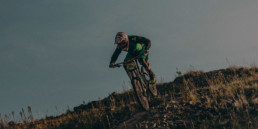A Future Ride.
How Bike Parks, Ski Resorts and Flow Trails are Enhancing the Mountain Biking Experience
Presented by Judd de Vall of Alpine Bike Parks (British Columbia, Canada), Nathan “Woody” Woodruff of Progressive Trail Designs (Arkansas, USA), and Chris Bernhardt of IMBA Trail Solutions (Oregon, USA).
The explosion of bike parks, gravity-assisted riding at ski resorts and bike-optimized “flow trails” are as important to the movement as the advancement of bike technology.
PART 1
Flow Trails, Presented by Chris Bernhardt, IMBA Trail Solutions
Why are MTB users are different then other trail users? Riders are more likely to play with the trail, for exercise but also hope, jump, float, etc.
- Traditionally we have ridden trails not optimized for mtb users
- Flow Trails are optimized for the fun and efficiency of the bicycle
- Opportunities for play are highlighted
Flow Trails offer a rhythm that is suited for bicycles. Attributes include:
- Organic, meandering route lacking abrupt turns, straight sections etc.
- Synergy with the landscape — shouldn’t be forced into the landscape
- Useful opposition to user forces to maximize the efficiencies of the bike e.g. berm turns, camber tread surfaces
- Conservation of momentum, rewarding deliberate riding and providing for a deeper level of rider interface
- Bike disappears beneath you; trail leads the user forward
- Both art and science goes into flow trail building
Misconceptions about Flow Trails:
- Flow Trails are smooth (while many are buffed out they can be both rough and remain bike optimized)
- We build Flow Trails because we have big machines (we build them because they are what so many riders want)
- You can only build flow trails in the mountains (not true, successful examples have been built in Florida)
- Flow trails are homogenizing the core of mountain biking (there are thousands of traditionally built trails, but only hundreds of good Flow Trails)
PART 2
How Bike Parks and Trails Change a Community: Case Study of Bentonville, Arkansas. Presented by Nathan “Woody” Woodruff of Progressive Trail Designs (Arkansas, USA).
Bentonville community before trail effort:
- Small town, no trails, home to Wal-Mart
- Vision for a trail system began in 2006
Slaughter Pen bike park and trail system
- 2006 Slaughter Pen Phase 1: Freeride Park and 5 miles of trails
- 2007 Phase 2: 5 miles of trail (emphasis on challenge features)
- 2009 2 miles of DH-oriented trail – Highlight was Road to Trail Conversion which led to “The Play Pen”
- 2010 1-mile “Gateway” Trail – Designed by Progressive Trail Design and IMBA, built by PTD
- 2010-2011 Park renovation, replaced 3 bridges, added 2 bridges and 2 miles of trails
- Connects to elementary and junior high school facilities; used by both
The Progressive Playground
- Redefining “recess” which provides youth with alternative options for rec and skill development
- 2011 Lincoln JR High, Flow trail and ladder bridge
- 2012 Sugar Creek Elementary, 1 mile gateway trail
- Slaughter Pen DH/Flow Trail
- 2012 .74 mile trail, 15 tables, 20 berms and 3 progressive bike ramps
Community After Trails
Social Impacts:
- Established a strong volunteer base with more than 100 members
- Bike Bentonville founded to advocate for cycling in town
- Parks and Rec started bike camp
- Public schools embraced MTB
- PE for Life program, instructing all PE teachers in county and bought 30 bikes
Economic Impacts:
- Revenue generated by 48 events listed on yearly calendar
- Walmart Bike Share program with 500 registered users
- Local retailers, both bike and running
- Police launched a bike patrol unit
- Awarded Bicycle Friendly Community status
- Considered for IMBA Ride Center Status
PART 3
Creating Next-Generation Mountain Bike Parks, with Judd DeVall of Alpine Bike Parks.
Founded in 2007, Alpine Bike Parks began as the dream of former professional mountain biker Judd de Vall. Following his racing career, de Vall spent a decade developing trail projects for the IMBA before setting off on his own. Since then, Alpine has grown and flourished, recruiting an impressive staff of skilled professionals and establishing itself as an industry leader in the field of bike park and natural surface trail development.
The next generation of mountain bike parks will bring:
- Economic benefits
- Demographic shift
- Quality of life
The Alpine Bike Parks process for developing a bike park project:
- Envision project feasibility and planning
- Site survey
- Concept illustration
- Design development
- Schematic design and construction documentation
- Final engineering
- Implement construction
- Feature fabrication
- Installation of features and improvement of ride features
- Public use
- Post-construction services
- More info available from Alpine Bike Parks



